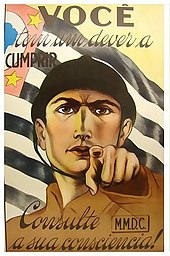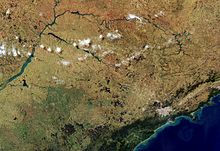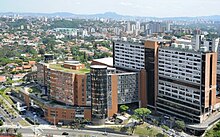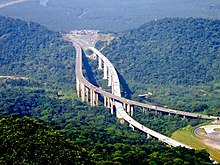São Paulo (state)
In the 17th century, the paulistas bandeirantes intensified the exploration of the colony's interior, which eventually expanded the territorial domain of Portugal and the Portuguese Empire in South America.After independence in 1822, São Paulo began to become a major agricultural producer (mainly coffee) in the newly constituted Empire of Brazil, which ultimately created a rich regional rural oligarchy, which would switch on the command of the Brazilian government with Minas Gerais's elites during the early republican period in the 1890s.There are even records (e.g. - studies at the Rincão I archaeological site) that suggest that ancient human occupation was already present in São Paulo 17 thousand years ago, during the last glacial maximum.Unwilling to shoulder the naval defense burden himself, the Portuguese ruler, King Joao III, divided the coast into "captaincies", or swathes of land, 50 leagues apart.The history of São Paulo city proper begins with the founding of a Jesuit mission of the Roman Catholic order of clergy on 25 January 1554—the anniversary of Saint Paul's conversion.Legend has it that in 1822 the regent was riding outside São Paulo when a messenger delivered a missive demanding his return to Europe, and Dom Pedro waved his sword and shouted "Independência ou morte!"In 1888, Brazil abolished slavery (it was the last country in the Americas to do so) and the freed African-Brazilians who had been helping build the nation were then forced to beg for their jobs back, working for food and shelter only because of the failure of the system to integrate them as equal citizens with Euro-Brazilians.The development of plantations in the 1890s, and widespread reliance on credit, took place against fluctuating prices and supply levels, culminating in saturation of the international market around the start of the 20th century.Wealthy Brazilians retreated to suburban highly secured housing complexes such as Alphaville, and favelas, pockets of substandard living slums that lined the periphery, had a tremendous growth.For the first time in history, Brazil experienced large segments of its population immigrating to continents such as North America, Europe, Australia, and East Asia, particularly to Japan.It is bordered by the states of Minas Gerais to the north and northeast, Paraná to the south, Rio de Janeiro to the east, Mato Grosso do Sul to the west, and the Atlantic Ocean to the southeast.Noteworthy is the Rio Grande, which born in Minas Gerais and join with Paranaiba to form the Parana River, which separates São Paulo from Mato Grosso do Sul.[10][37] According to an autosomal DNA genetic study from 2006, European genes account for 79% of the heritage of the people of São Paulo state, 14% are of African origin, and 7% Native American.[46] According to data from the "Map of Violence 2011", published by the Sangari Institute and the Ministry of Justice, the homicide rate per 100,000 inhabitants in the state of São Paulo is the lowest in Brazil.[65] The Brazilian Social Democracy Party (PSDB) held the governorship and the speakership of the state' Legislative Assembly from 1994 to 2022, when governor Rodrigo Garcia, lost the election to Tarcisio de Freitas (Republicanos).[69] Its economy is based on machinery, the automobile and aviation industries, services, financial companies, commerce, textiles, orange growing, sugar cane and coffee bean production.Service and financial sectors, as well as the cultivation of oranges, cane sugar and coffee form the basis of an economy which accounts for 34% of Brazil's GDP (equivalent to US$727.053 billion).The state is also at the vanguard of ethanol production, soybeans, aircraft construction in São José dos Campos, and its rivers have been important in generating electricity through its hydroelectric plants.Moreover, São Paulo is one of the world's most important sources of beans, rice, oranges and other fruit, coffee, sugar cane, alcohol, flowers and vegetables, maize, cattle, swine, milk, cheese, wine, and oil producers.Textile and manufacturing centers such as Rua José Paulino and 25 de Março in São Paulo city is a magnet for retail shopping and shipping that attracts customers from the whole country and as far as Cape Verde and Angola in Africa.In agriculture, it is a giant producer of sugar cane and oranges, and also has large production of coffee, soy, maize, bananas, peanuts, lemons, persimmons, tangerines, cassavas, carrots, potatoes and strawberries.In 2017, this index decreased to 46.6%, and in 2019, to 40.1%, due to a phenomenon of internalization of vehicle production in Brazil, driven by factors such as unions, which made payroll and labor burdens excessively burdensome, discouraged investment, and favored the search for new cities.São Paulo created companies such as: Yoki, Vigor, Minerva Foods, Bauducco, Santa Helena, Marilan, Ceratti, Fugini, Chocolates Pan, Embaré, among others.The companies that benefited the most from the sale of medicines in the country in 2015 were EMS, Hypermarcas (NeoQuímica), Sanofi (Medley), Novartis, Aché, Eurofarma, Takeda, Bayer, Pfizer and GSK.After this publication, many others of the genre appeared, such as the watercolor "The Navel of São Paulo" (1827), by Jean-Baptiste Debret, and works and/or reports by Augustin Saint-Hilaire (1819), Hércules Florence (1826) and Daniel Kidder (1837).Regarding historical and architectural tourism, the highlights include the Historic Center, Pátio do Colégio, Municipal Market, Luz Station, and iconic buildings and monuments in the country's history, such as Altino Arantes, Copan, Itália, Martinelli, Mirante do Vale, Hotel Unique, Conjunto Nacional, Octávio Frias de Oliveira Bridge, Catedral da Sé, Obelisk of São Paulo, Marco Zero, and Monumento do Ipiranga.[155] With 654 km, the Rodovia Raposo Tavares (SP-270) is the longest highway in the state and connects the capital, where it begins in Butantã, to the west of São Paulo, extending to the border with Mato Grosso do Sul in Presidente Epitácio.The winning companies in the bidding process were forced to make a series of investments and meet quality targets, but, despite the improvement in accident statistics,[157] the charging of a toll considered high by Brazilian standards provokes criticism of the privatization model.In rail transport, the state has more than 5,000 km (3,100 mi) of railways, which comes from the banks of the Parana River on the border of São Paulo and Mato Grosso do Sul, to the Port of Santos, on the Atlantic coast, for the carriage of goods.Most of the main athletes and sportsmen in the history of Brazil come from São Paulo, such as: Ayrton Senna, César Cielo, Oscar Schmidt, Hortência Marcari, Éder Jofre, Robert Scheidt, Emerson Fittipaldi, Aurélio Miguel, Rogério Sampaio, Alex Barros, Gustavo Borges, Ricardo Prado, Adhemar da Silva, João Carlos de Oliveira, Maurren Maggi, Fabiana Murer, Thiago Braz, Alison dos Santos, Arthur Zanetti, Rebeca Andrade, Rubens Barrichello, Felipe Massa and many others.


























Bandeirante StateBandeirantes AnthemCountryBrazilNamed forPaul the ApostleCapitalSão PauloLegislative AssemblyGovernorTarcísio de FreitasFelicio RamuthSenatorsAlexandre GiordanoMarcos PontesMara GabrilliDemonymPaulistaGDP (nominal)Time zoneISO 3166 codeLicense Plate Letter Sequence26 statesFederative Republic of BrazilSaint Paul of TarsusSoutheast RegionMinas GeraisParanáRio de JaneiroMato Grosso do SulAtlantic Ocean645 municipalitiesUnited Kingdommunicipality of São Pauloworld's 28th-most-populoussub-national entityAmericasSouth AmericaColombiaArgentinaItaliansPortugueseIndigenous peoplesethnic groupsAfricansAfricacolonial eraArmeniansChineseGermansGreeksJapaneseSpanishAmerican SouthernersMartim Afonso de SousaSão VicenteBaixada SantistabandeirantesPortugalindependencecoffeeEmpire of Braziloligarchyearly republican periodVargas Eraindustrializationeconomylargest industrialscientifictechnologicalorange juiceethanolhighest GDPdevelopedUruguayParaguayBoliviadollars21st largest in the worldBrazilian touristcultural heritageUNESCOWorld Heritage Listbusinessentertainmentfashionsecond-highestper capitasecond-lowest infant mortality ratethird-highest life expectancythird-lowest rate of illiteracyHistory of the state of São PauloAmerindianglacial maximumlithic industryhunter-gatherersnomadsTupi peopleJoão RamalhoSantosBenedito CalixtoEnglishFrenchprivateerJoao IIIIndianJesuitRoman CatholicSaint PaulSão Paulo dos Campos de PiratiningaSanto André da Borda do CampoTietê-ParanapanemaenslavingAntónio Raposo TavaresbandeiranteSilverdiamondsPortuguese crownAmazonAndes MountainsNapoleon's invasion of PortugalBritishRoyal NavyJoão VI of PortugalLisbonAtlantic


